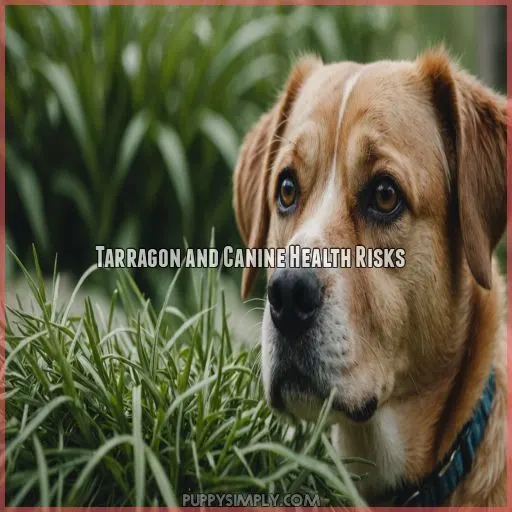This site is supported by our readers. We may earn a commission, at no cost to you, if you purchase through links.

Tarragon contains estragole, which can upset your dog’s tummy or even cause more serious issues like liver damage. It’s like giving your dog a Jack-in-the-box – you never know what’ll pop up!
Always check with your vet before adding this herb to your pup’s plate, and use it sparingly. Safer options, like parsley or basil, are less risky but just as flavorful.
Curious about other pet-friendly herbs and their benefits? There’s a whole garden of information awaiting!
Table Of Contents
- Key Takeaways
- Is Tarragon Safe for Dogs?
- Health Benefits of Tarragon for Dogs
- Can Dogs Eat Tarragon Chicken?
- Tarragon in a Dog’s Diet
- Types of Dogs That Should Avoid Tarragon
- Alternatives to Tarragon for Dogs
- Tarragon Toxicity in Dogs
- Veterinary Advice on Tarragon
- Tarragon and Canine Health Risks
- Frequently Asked Questions (FAQs)
- What herbs can dogs not eat?
- Can dogs eat tarragon chicken?
- Who should not eat tarragon?
- What are anti inflammatory spices for dogs?
- How does tarragon affect a dogs behavior?
- Can tarragon help in controlling dog allergies?
- Is tarragon safe for puppies to consume?
- What are signs of tarragon overdose in dogs?
- How to introduce tarragon safely to dogs?
- Conclusion
Key Takeaways
- If you’re thinking of letting your dog try tarragon, think twice. Estragole, a pesky compound in it, can upset their tummy and even damage the liver. It’s like offering them a spicy mystery, so tread lightly and ask the vet first.
- While tarragon flaunts benefits like antioxidants and anti-inflammatory perks, its charm isn’t worth the gamble for all pooches. Consider safer herbs like parsley or basil, which won’t have your pup barking up the wrong tree.
- Got a pup with allergies or liver issues? Keep tarragon off the menu. It’s like inviting trouble to a dinner party – a recipe for disaster when it comes to sensitive dogs. Allergic reactions can mimic a bad case of poison ivy, so be forewarned.
- Wondering if you can serve your dog a taste of tarragon chicken? Think plain. Keep the flavoring subtle and sparing. Remember, your furry friend isn’t a sophisticated food critic, so keep their palate simple and their tummy trouble-free.
Is Tarragon Safe for Dogs?
Tarragon may pose some risks for canine companions. While this herb offers potential health benefits, it’s important to understand the potential dangers and take precautions when feeding it to your dog.
Risks of Tarragon for Canines
Tarragon can be a mixed bag for dogs. While its health benefits entice, the risks aren’t trivial. Ponder these factors:
- Estragole Effects: Can cause liver damage or blood clotting issues.
- Tarragon Toxicity: Watch for upset stomach or other side effects.
- Allergic Reactions: Itching or swelling may occur.
- Veterinary Advice: Always consult your vet before adding it to your dog’s diet.
Toxic Compounds in Tarragon
You know how you wouldn’t let your dog play with fire? Tarragon’s kinda like that. Packed with estragole, a toxic compound, it poses herb risks if consumed in excess. Consider this table, for instance:
| Compound | Effect on Dogs | Safe Level | Avoidance Tip |
|---|---|---|---|
| Estragole | Toxic | Very low | Use sparingly |
Keeping dog safety in mind is key!
Potential Side Effects in Dogs
When feeding your furry buddy tarragon, understanding potential side effects is important. Estragole in tarragon can cause issues like:
- Allergic Reactions: Think itching or swellinglike your dog rolled in poison ivy!
- Seizures: Suppose your pet experiences unusual twitching.
- Blood Clots: This is like a traffic jam in their veins.
Always balance food choices and evaluate health conditions first!
Health Benefits of Tarragon for Dogs
While tarragon may pose some risks for our canine companions, this versatile herb can actually offer a range of health benefits. From its antioxidant and anti-inflammatory properties to its natural insect-repelling abilities, tarragon just might be the secret ingredient your pup needs for a healthier, happier life.
Antioxidant and Anti-Inflammatory Properties
Boosting your dog’s health can be a walk in the park with tarragon. Rich in antioxidants, it supports their immune system, reducing inflammation like a champ. Picture it as a knight in shining armor for your pup’s health. But remember, moderation is key to prevent potential risks.
| Property | Benefit | Usage Tip |
|---|---|---|
| Antioxidants | Cell protection | Add sparingly to meals |
| Anti-inflammatory | Eases discomfort | Consult vet if unsure |
| Nutrients | Supports nutrition | Balance with other herbs |
Natural Insect Repellent Properties
Hey, did you know tarragon’s like nature’s tiny warrior in the battle against fleas and ticks? If you’ve ever struggled with these pesky critters, tarragon can lend a paw.
Here’s how it helps:
- Acts as a natural flea repellent.
- Provides tick control without harsh chemicals.
- Supports DIY remedies for pest-free pooches.
Can dogs eat tarragon for this? Not typically!
Digestive Health Benefits
Let’s talk about dog tummy troubles! Tarragon might just be the secret ingredient for boosting your pup’s digestion. Its ability to stimulate enzyme production helps with digestion and could ease digestive issues. You wouldn’t believe how nature serves up these benefits!
| Benefit | Effect |
|---|---|
| Gut Health | Improved enzyme function |
| Digestive Issues | Eases discomfort |
| Enzyme Production | Enhances digestion |
Who would’ve thought this little herb packs such a punch?
Potential Relief From Arthritis Symptoms
Tarragon’s anti-inflammatory properties could provide some relief for your pup’s achy joints. The natural herb may help ease arthritis symptoms and reduce inflammation, potentially improving mobility and comfort. Just be sure to consult your vet before adding tarragon or any new supplements to your dog’s diet. A little goes a long way with this potent herb.
Can Dogs Eat Tarragon Chicken?
You might wonder if sharing your tarragon chicken with your furry friend is a good idea, but caution is key here. While a small amount of tarragon can offer some benefits, serving it in moderation and ensuring the chicken is plain without harmful seasonings is important.
Precautions for Feeding Tarragon to Dogs
So, tarragon’s fantastic benefits are there, but hold your horses! Let’s talk safety before serving that tarragon chicken to your furry pal:
- Tarragon Quantity: Use sparingly.
- Dog Breed: Consider unique sensitivities.
- Allergic Reactions: Look out for itching or swelling.
- Liver Health: Avoid for pups with liver issues.
A little humor? They’re no culinary critics!
Safe Preparation Methods
After considering precautions, focus on safe preparation methods. When cooking with tarragon for your furry pal, always opt for fresh or dried tarragon sparingly. Avoid herb blends with garlic or onions, which are harmful to dogs. Cook tarragon chicken plainly—skip the spicy marinades. Store herbs safely to prevent curious noses from munching. Who knew cooking could require a watchdog?
Recommended Serving Sizes
If you’re thinking about giving your pup tarragon chicken, start small.
For small dogs, a teaspoon or two per meal is a good rule of thumb.
Larger dogs can handle a bit more, maybe a tablespoon or two.
But don’t go overboard – a little tarragon goes a long way!
Mix it into their regular food and monitor for any tummy troubles.
Tarragon in a Dog’s Diet
Tarragon can add flavor and nutrition to your dog’s meals, but only when used correctly. As you spice up your pup’s diet, balancing tarragon with other herbs might just prevent your furry friend from turning up their nose at dinner time!
Role of Herbs in Canine Nutrition
Ever pondered the role of herbs in your dog’s diet? Well, herbs can be a game-changer! They offer numerous benefits:
- Herb safety: Helps create a healthy diet.
- Herb benefits: Enhance immune function.
- Herb risks: Use cautiously to avoid digestive issues.
Nutritional Value of Tarragon for Dogs
Herbs like tarragon can spice up your dog’s diet with beneficial nutrients. This herb is loaded with vitamin A for good vision and immune health, plus vitamin C to fight those pesky free radicals. It also contains calcium and iron, essential for strong bones and energy levels. So, tarragon packs quite a nutritious punch, despite being small.
Balancing Tarragon With Other Herbs
When incorporating tarragon into your dog’s diet, it’s important to strike the right balance with other herbs.
Pair tarragon with complementary flavors like parsley, basil, or rosemary to create a harmonious blend.
Adjust the ratios to suit your pup’s preferences and make sure the overall herb mix is safe and palatable.
A little culinary creativity can go a long way in keeping your canine companion happy and healthy.
Types of Dogs That Should Avoid Tarragon
You probably think your dog could handle anything, but around tarragon, some pups need a time-out. Dogs with liver issues, allergies, or blood clotting disorders should steer clear of tarragon to avoid any potential health mishaps.
Dogs With Pre-Existing Liver Issues
Worried about liver health risks for your pup? Dogs with pre-existing liver issues should skip tarragon, as it can stir trouble like a rock in a hornet’s nest. Instead, consider tarragon alternatives and liver supplements for dietary adjustments. Always chat with your vet for personalized advice. After all, a happy dog equals peace of mind!
Dogs With Allergies or Sensitivities
Some dogs, just like folks allergic to pollen, have a sensitivity to tarragon. Does your dog exhibit tarragon allergy symptoms? Watch for:
- Itchy skin, like a pup with fleas.
- Swelling or hives.
- Runny nose or sneezing.
- Upset tummy or loose stools.
- Reluctance to eat flavored foods.
See your vet for canine allergy testing and safe herbs for dogs!
Dogs With Blood Clotting Disorders
If your canine companion has a blood clotting disorder, it’s best to steer clear of tarragon. This herb can interfere with normal blood coagulation, potentially leading to life-threatening complications. Consult your veterinarian before introducing any new herbs or supplements, as they can provide personalized guidance on safe dietary choices for your pup’s unique needs.
Alternatives to Tarragon for Dogs
If you’re wondering about safer alternatives to tarragon for your dog’s diet, you’re in the right place! Explore herbs that offer similar benefits without the risks, but always check with your vet before making any changes to Fido’s menu.
Safe Herbal Options for Canines
For dog-safe herb guides, not all herbs are created equal. Consider options like parsley or thymenature’s little helpers. Theyre packed with canine herb benefits without the risks of tarragon. These herbal remedies for dogs can boost digestion and even help with allergies. Remember, always chat with your vet before changing things up.
Herbs With Similar Health Benefits
As you explore herbal options for your pup, think parsley, cilantro, rosemary, basil, and oregano. They’re like the Fab Five of dog-friendly herbs. These tasty plants pack antioxidant punches without the punch of tarragon’s potential risks.
- Parsley: Freshens breath like a charm.
- Cilantro: Digestive system superhero.
- Rosemary: Brain-boosting buddy.
- Basil: Soothes joint aches.
- Oregano: Immunity’s trusted knight.
Consultation With a Veterinarian
While herbs like tarragon can offer potential benefits, it’s always best to consult your veterinarian before introducing any new ingredients to your dog’s diet, just like you would with dog food safety. They can provide personalized guidance on safe, vet-approved herbs and the proper dosages to keep your pup healthy and happy. Your vet’s expertise is invaluable in caring for your canine companion’s unique needs.
Tarragon Toxicity in Dogs
Your pup might love sniffing out new flavors, but tarragon isn’t the best treat due to its potential toxicity. Keep an eye out for symptoms like vomiting or lethargy, and if your dog gets into this herb, knowing what to do next can be a real lifesaver.
Signs of Tarragon Poisoning in Dogs
Spotting tarragon poisoning in your dog is no walk in the park! Keep your eyes peeled for vomiting, diarrhea, or seizures—red flags waving on a stormy sea. A lethargic dog may act like they’re stuck in a Monday morning rut, and tremors could mimic a dance gone wrong. Always put your pup’s paws on safe ground by staying alert.
Emergency Treatment for Tarragon Toxicity
If your pup’s chowed down too much tarragon, it’s time to hustle. Check for tarragon poisoning symptoms like vomiting, dizziness, or seizures. Quick actions that can help:
- Call the vet pronto
- Induce vomiting with their guidance
- Use activated charcoal
- Keep water handy
- Monitor for changes
Prevention of Tarragon Overconsumption
To prevent tarragon overconsumption, store it securely out of your pup’s reach. Some dogs may find the strong aroma and flavor irresistible, so be mindful of their curious nature. Consider offering safer alternatives like parsley or basil instead. If you suspect your dog has ingested too much tarragon, contact your vet right away.
Veterinary Advice on Tarragon
When you’re considering adding tarragon to your dog’s diet, it pays to get some veterinary advice to make sure it’s a good fit. Vets can help you understand how it might benefit your furry friend and guide you on safely incorporating it without turning your pup’s mealtime into an accidental herbal experiment.
When to Use Tarragon for Canine Health
When you’re weighed down by the possible toxicity of tarragon, let’s shift gears to when it can be beneficial for your furry friend. Think of tarragon as a superhero spice, swooping in for:
- Boosting dog digestion.
- flea control with natural repellents.
- Arthritis relief through anti-inflammatory properties.
- Enhancing immune support with antioxidants.
Cheers to happy, healthy pups!
Guidelines for Herb Usage in Dogs
You might’ve thought about tarragon for your pup, right? Herb safety is key, so here’s the scoop: always get vet approval first. Check the table below for quick tips on using herbs.
| Herb Aspect | Safe Practice | Dog Benefit |
|---|---|---|
| Fresh vs Dried | Use fresh sparingly | Maintains vitamins |
| Herb Dosage | Small amounts | Enhances digestion |
| Dog Allergies | Watch for signs | Reduces risks |
Monitoring for Adverse Reactions
Keep a close eye on your pup after introducing tarragon. Watch for any signs of an allergic reaction, like itching, swelling, or breathing troubles. Every dog’s tolerance is different, so monitor closely, especially in the first few uses. Over time, look out for any long-term effects on your canine companion’s health.
Tarragon and Canine Health Risks
Before adding tarragon to your dog’s diet, it’s important to think about potential health risks and interactions with medications. A vet’s advice can be your best friend here, making sure your pup doesn’t bark up the wrong tree with unexpected side effects!
Potential Interactions With Medications
Your vet’s advice about tarragon for dogs is important to pay attention to, especially to avoid medication hiccups. Tarragon might tango with some drugs, leading to surprises you didn’t order. Keep an eye out for:
- Blood thinners getting overly enthusiastic
- Changes in liver medications’ effectiveness
- Interactions with any anti-inflammatory drugs
- Altered absorption of vitamins or supplements
Stay savvy, consult your vet!
Contraindications for Tarragon Use in Dogs
Watching for contraindications when feeding tarragon to your dog is like knowing when it’s time to tap out in a wrestling match. Dogs with liver issues, blood clotting disorders, or allergies should skip this herb. Also, pregnant pups—give tarragon a hard pass. It’s not the right time for experiments; your pooch’s health is non-negotiable.
Importance of Veterinary Consultation
Talking to your vet is really important when thinking about giving tarragon to your pup.
They’ll check for any health problems, possible drug interactions, and figure out the right amount of tarragon for your dog based on their specific needs.
Your vet can also give you advice on watching for allergic reactions or other side effects.
Their expertise makes sure your furry friend’s well-being comes first.
Frequently Asked Questions (FAQs)
What herbs can dogs not eat?
Picture your dog sniffing the gardensome herbs like garlic, onions, chives, and leeks are their kryptonite. Keep these out of their diet to make sure they stay safe and healthy. After all, a happy dog is priceless!
Can dogs eat tarragon chicken?
While tarragon can provide some health benefits for dogs, it’s best to use it sparingly. The strong flavor may not appeal to all pups, and large amounts can cause digestive upset or other issues. Consult your vet before adding tarragon to your dog’s diet.
Who should not eat tarragon?
If you’re pregnant or have liver issues, avoid tarragon—it contains estragole, possibly harmful in large amounts. Some folks might also have allergies to herbs. Like adding chili to ice cream, it’s not for everyone!
What are anti inflammatory spices for dogs?
If you’re looking for anti-inflammatory spices for dogs, don’t beat around the bush. Turmeric, ginger, and fennel pack a punch. They help reduce inflammation and aid joint health. Always check with your vet before adding them.
How does tarragon affect a dogs behavior?
Tarragon‘s strong aroma might tickle your dog’s curiosity, but it’s best to keep their tails wagging away from it. The estragole compound can cause behavioral issues like restlessness due to potential toxic effects. Better safe than sorry!
Can tarragon help in controlling dog allergies?
Tarragon may help control dog allergies by reducing inflammation and boosting the immune system. Its natural anti-inflammatory properties can ease allergy symptoms like itching and swelling. (Source)
Is tarragon safe for puppies to consume?
Puppies should steer clear of tarragon. While it offers benefits for adult dogs, it contains estragole, which can be harmful in large amounts, potentially causing digestive issues or liver damage in pups. Stick to puppy-safe herbs instead!
What are signs of tarragon overdose in dogs?
Overdid it with tarragon in your pup’s food? They might show signs like vomiting, diarrhea, or even seizures. If you see these symptoms, consult a vet right away. Better safe than sorry, right?
How to introduce tarragon safely to dogs?
Introduce tarragon to your dog by starting with a tiny pinch mixed into their food. Monitor your pup for any reactions. Remember, moderation is key—like sneaking veggies into a kid’s pasta! Safety first, flavor second.
Conclusion
Tarragon, while flavorful, can be dangerous for dogs.
It’s best to consult your veterinarian before giving your dog any tarragon.
Safer alternatives for your dog’s diet include sage and sweet potato.
Always be cautious when introducing new foods to your dog’s diet.















